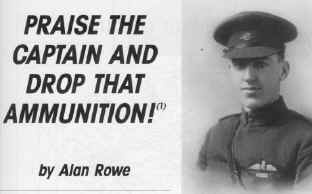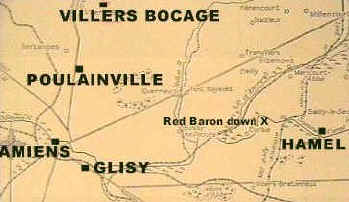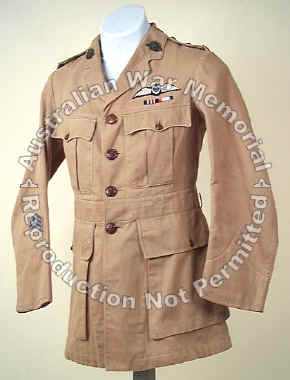 |
|
|||
| 3 Squadron AFC |
|
|
|
| Formed: | September 1916 | ||
| Disbanded: | February 28 1919 | ||
| Aircraft: | Curtis Jenny, Armstrong Whitworth, FK8, BE2e, Bristol Fighter | ||
| Aces: | Nil | ||
| Stationed: | Point Cook: September - October 1916 South Carton: December 1916 - September 1917 Savy: September 1917 - November 1917 Bailleul: November 1917 - March 1918 Abeele: March - April 1918 Poulainville: April - May 1918 Villers-Bocage: May - September 1918 Proyart: September 1918 Bouvincourt: September - October 1918 Montigny: October 1918 Premont: October - December 1918 Charleroi: December 1918 - February 1919 |
||
|
3 Squadron AFC was formed at Point Cook on September 19 1916 under the command of Major D V J Blake. It became the first Australian squadron to arrive in Europe when it arrived in England in December for further training. Equipped with RE8 aircraft the squadron moved to Savy in France in September 1917 where it's major role was that of reconnaissance, bombing and strafing. In November it moved to Bailleul in Flanders where it became the reconnaissance squadron for the 1st ANZAC Corps. In this role it supported Australian troops for the remainder of the war. After the war ended the squadron provided a air mail service for the Allied armies before being disbanded in February 1919. The squadron markings for 3AFC was a white disc immediately aft of the roundel but from April 1918 onwards the only markings were individual letters. |
| Monash also asked for 18 planes to bomb Hamel, as well as older, noisier ones to distract attention from the noise of the tanks' whereabouts and movements. Several arms of attack were coordinated through the detailed and organised planning of Monash and his senior officers. All decisions and strategies were outlined, refined and formalised in group meetings. |
|

Capt. Lawrence J Wackett DFC Nov 1918 |
At 5.45am an RE8 flown by Lt G Newton with Lt A Renolds as his observer lifted off from the airfield of 3 Sqn AFC at Villers Bocage for a 10 minute flight to the battle front near the German held village of Hamel. |
| It was the first of 13
RE8 machines that would continually return to that area throughout the
day, contributing to the success of the ground offensive- and also
making aviation history.
Visibility in the air was reported to be fair with some cloud at the 2000 foot level. At about 6.00am Newton pulled the wooden toggle of his Bowden cable operated bomb release but instead of the usual 20lb Cooper bombs falling away, two heavy wooden crates attached to a 14ft diameter parachute floated gently down to earth. Each of those boxes weighed approximately 100lbs and contained four 250 round belts of ammunition for a Vickers machine gun. This was the first ever recorded supply of ammunition by parachute to troops in battle. It was an Australian organised operation, carried out by 3 Sqn AFC with some practical assistance from RAF. Extract from a Cross & Cockade article. |
| 3
Sqn AFC and The Battle of HAMEL (4 Jul 1918)
The Squadron first moved south to POULAINVILLE from ABEELE and later formed a forward landing ground at GLISY. Air combats became daily affairs whilst RE8s carried out their photographic missions (over 90,000 prints |
 |
| taken), bombing and trench
strafing, reconnaissance generally and troop and artillery
spotting duties. They were at POULAINVILLE when the Red Baron
went down near Corbie.
On 4 May 1918, the Squadron moved 3.5 air miles (5.6km) north to VILLERS BOCAGE where they stayed for 4 months carrying out much the same duties as before. The RE8s were also used to create diversions and make noise to cover advancing troops and particularly tank forces. Dropping smoke bombs to screen advancing troops and dropping ammunition to fighting soldiers were other duties. Extract from 3 Sqn History |
 |
This jacket was worn by Lieutenant (Observer) Alec Stewart Paterson, Australian Flying Corps (AFC). Enlisted as a bombardier (SN 8431) in the AIF field artillery at Adelaide on 18 August 1915. Awarded the Military Medal in December 1916. Commissioned with the rank of lieutenant in the AFC on 26 July 1917. Attended the RFC Gunnery School in Kent and a course at 'B' Flight Artillery Cooperation Squadron RFC, both in August, and then the Australian Sub-Pool Wireless & Observers School, Hursley Park, Winchester, in November, before being posted to 3 Squadron. On patrol with Captain (flight commander) J R Duigan on 22 April 1918, he is credited with being the first to detect the German railway gun that was shelling Amiens from Harbonnieres. The railway gun was captured by 31 Battalion AIF on 8 August and subsequently sent to the Australian War Memorial. It is now referred to as the 'Amiens Gun' and is in the AWM collection at REL/19643. |
| On 9 May his RE8 aircraft was attacked by four German triplanes whilst on a photography patrol over Villers-Bretonneux. He and Duigan were both wounded in the engagement but they managed to fly their aircraft back to their own lines. Taken to 8 General Hospital suffering gunshot wounds to the right arm, head, right shoulder, left hand and right foot, he was later moved from there to the Central RFC Hospital in Hampstead, England, and invalided home to Australia on 12 December 1918. | |
3 Squadron AFCNote on Squadron numbering: The unit that would become known as 3 Squadron, Australian Flying Corps (AFC), was formed at Point Cook, in Victoria on 19 September 1916. It was initially designated 2 Squadron. On 31 March 1917 (in England) it was redesignated 69 Squadron (Australian) Royal Flying Corps (RFC). On 20 January 1918 the unit was finally designated 3 Squadron AFC. For ease of comprehension 3 Squadron has been used throughout the following entry. ******************************************************** 3 Squadron, the first Australian flying unit to arrive on the Western Front, was originally formed in September 1916 at Point Cook in Victoria. Transported to Europe on HMAT Ulysses, it landed in England on 28 December 1916 and was sent for training to South Carlton, Lincolnshire. Training on AVRO 504 and BE-2e aircraft lasted eight months and in July 1917 the squadron was mobilised for France. On 24 August 1917 three flights (each of six RE-8 aircraft) left South Molton for Lympne in Kent. Delayed by bad weather, the squadron finally arrived at their appointed aerodrome in France (Savy) on 10 September 1917. The squadron was subsequently employed in support of the ground forces, operating over the Canadian and XIII Corps’ front near Arras. In November 1917, the squadron moved to Flanders to operate in support of the Australian Corps. Its duties included locating enemy gun emplacements, artillery spotting and bombing patrols. In early 1918, operations extended to dropping propaganda leaflets and, in February, photographic reconnaissance work. During the German spring offensive, the squadron moved to the Somme valley and was involved in vital artillery spotting operations. On 21 April 1918, 3 Squadron aircraftbecame involved in the action leading to the death of the German air ace Manfred von Richthofen. In late June 1918 the squadron was involved in experiments in aerial supply methods for ground troops and in July contributed to noise diversion operations in connection with the battle of Hamel. The squadron also assisted Allied movements in the battle of Amiens by dropping smoke bombs and continued its reconnaissance duties during the Allied advance to the Hindenburg Line. The squadron’s last offensive operations took place on 10 November 1918, the day before the signing of the Armistice. After the Armistice the squadron supported Allied forces in the move to the German frontier and was also used to provide a postal air service for the AIF. On 21 February 1919 the squadron began its move to Hurcott Camp, near Salisbury and on 6 May 1919 embarked on RMS Kaisar-i-Hind at Southampton and sailed for Australia, arriving at Port Adelaide on 16 June 1919. Text from AWM
|

